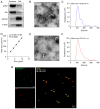Engineered extracellular vesicles with polypeptide for targeted delivery of doxorubicin against EGFR‑positive tumors
- PMID: 39329273
- PMCID: PMC11465103
- DOI: 10.3892/or.2024.8813
Engineered extracellular vesicles with polypeptide for targeted delivery of doxorubicin against EGFR‑positive tumors
Abstract
Lack of effective tumor‑specific delivery systems remains an unmet clinical challenge for the employment of chemotherapy using cytotoxic drugs. Extracellular vesicles (EVs) have recently been investigated for their potential as an efficient drug‑delivery platform, due to their good biodistribution, biocompatibility and low immunogenicity. In the present study, the formulation of GE11 peptide‑modified EVs (GE11‑EVs) loaded with doxorubicin (Dox‑GE11‑EVs), was developed to target epidermal growth factor receptor (EGFR)‑positive tumor cells. The results obtained demonstrated that GE11‑EVs exhibited highly efficient targeting and drug delivery to EGFR‑positive tumor cells compared with non‑modified EVs. Furthermore, treatment with Dox‑GE11‑EVs led to a significantly inhibition of cell proliferation and increased apoptosis of EGFR‑positive tumor cells compared with Dox‑EVs and free Dox treatments. In addition, it was observed that treatment with either free Dox or Dox‑EVs exhibited a high level of cytotoxicity to normal cells, whereas treatment with Dox‑GE11‑EVs had only a limited effect on cell viability of normal cells. Taken together, the findings of the present study demonstrated that the engineered Dox‑GE11‑EVs can treat EGFR‑positive tumors more accurately and have higher safety than traditional tumor therapies.
Keywords: EGFR‑positive cancer; chemotherapy; colorectal cancer; engineered extracellular vesicles; glioma; targeted drug delivery.
Conflict of interest statement
The authors declare that they have no competing interests.
Figures






Similar articles
-
Inhibitory Effect of Oxaliplatin-loaded Engineered Milk Extracellular Vesicles on Tumor Progression.Anticancer Res. 2022 Feb;42(2):857-866. doi: 10.21873/anticanres.15543. Anticancer Res. 2022. PMID: 35093883
-
Targeting capacity, safety and efficacy of engineered extracellular vesicles delivered by transdermal microneedles to treat plasmacytoma in mice.Clin Transl Med. 2025 May;15(5):e70327. doi: 10.1002/ctm2.70327. Clin Transl Med. 2025. PMID: 40317915 Free PMC article.
-
Extracellular vesicles derived from dendritic cells loaded with VEGF-A siRNA and doxorubicin reduce glioma angiogenesis in vitro.J Control Release. 2024 May;369:128-145. doi: 10.1016/j.jconrel.2024.03.042. Epub 2024 Mar 26. J Control Release. 2024. PMID: 38522817
-
Application of engineered extracellular vesicles for targeted tumor therapy.J Biomed Sci. 2022 Feb 21;29(1):14. doi: 10.1186/s12929-022-00798-y. J Biomed Sci. 2022. PMID: 35189894 Free PMC article. Review.
-
Engineered extracellular vesicles: A novel platform for cancer combination therapy and cancer immunotherapy.Life Sci. 2022 Nov 1;308:120935. doi: 10.1016/j.lfs.2022.120935. Epub 2022 Sep 6. Life Sci. 2022. PMID: 36075472 Review.
Cited by
-
Harnessing engineered extracellular vesicles for enhanced therapeutic efficacy: advancements in cancer immunotherapy.J Exp Clin Cancer Res. 2025 May 2;44(1):138. doi: 10.1186/s13046-025-03403-w. J Exp Clin Cancer Res. 2025. PMID: 40317075 Free PMC article. Review.
-
Emerging Biomimetic Drug Delivery Nanoparticles Inspired by Extracellular Vesicles.Wiley Interdiscip Rev Nanomed Nanobiotechnol. 2025 Jul-Aug;17(4):e70025. doi: 10.1002/wnan.70025. Wiley Interdiscip Rev Nanomed Nanobiotechnol. 2025. PMID: 40840553 Free PMC article. Review.
-
Surface Functionalization of Nanocarriers with Anti-EGFR Ligands for Cancer Active Targeting.Nanomaterials (Basel). 2025 Jan 21;15(3):158. doi: 10.3390/nano15030158. Nanomaterials (Basel). 2025. PMID: 39940134 Free PMC article. Review.
References
MeSH terms
Substances
LinkOut - more resources
Full Text Sources
Research Materials
Miscellaneous

